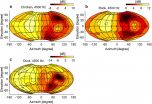(Press-News.org) MAYWOOD, Il. - Riding a couple roller coasters at an amusement park appears to have triggered an unusual stroke in a 4-year-old boy, according to a report in the journal Pediatric Neurology.
The sudden acceleration, deceleration and rotational forces on the head and neck likely caused a tear in the boy's carotid artery. This tear, called a dissection, led to formation of a blood clot that triggered the stroke, Loyola University Medical Center neurologist Jose Biller, MD and colleagues report.
Strokes previously have been reported in adult roller coaster riders, but there are only a few previous reports of strokes in children who rode roller coasters, including a 13-year-old girl and an 11-year-old boy. The 4-year-old boy described by Loyola neurologists is one of the youngest reported in the medical literature.
Prior to his stroke, the 4-year-old boy was healthy. During an out-of-state vacation with his parents, he rode two roller coasters. The first ride was 679 feet long and 30 feet high, with a top speed of 25 mph. The second ride had a 53-foot drop with a descent speed of 40 mph.
The day after riding the roller coasters, the boy vomited and developed a droop on the left side of his face while on the flight back home. By the time he arrived home, he was unable to walk and had weakness on his left side. He was rushed to the hospital, where imaging exams showed he had experienced a carotid artery dissection and stroke. He received low-dose aspirin and doctors observed a steady improvement. At a six-month follow-up visit, his gait had improved considerably, and he had only mild muscle weakness and stiffness on the left side.
Sudden movements that can hyperextend the neck or rotate the neck - such as whiplash, certain sports movements or even violent coughing - can result in a dissection of the carotid artery. A dissection begins as a tear in one layer of the artery wall. A blood clot can form in the area of the tear. If it's large enough, the clot can block blood flow to the brain. Or, pieces of the clot can break free, travel up to the brain and block blood flow to the brain. In either case, the result is a stroke.
A child under age 10 is vulnerable to sudden neck movements and rotations due to weak neck muscles, a relatively large head and other factors. "This hypermobility, combined with other kinetic and linear forces experienced during a roller coaster ride, could theoretically explain why some children, albeit rarely, sustain dissections," Dr. Biller and colleagues wrote.
Dr. Biller is an internationally known expert on strokes in children and young adults. He has written a textbook on the topic and is a co-author of the American Heart Association's guidelines for management of stroke in infants and children. Dr. Biller notes that about 15 percent of the most common type of strokes (caused by blood clots) occur in adolescents and young adults.
INFORMATION:
Dr. Biller is chair of the Department of Neurology of Loyola University Chicago Stritch School of Medicine.
The paper in Pediatric Neurology is titled "Internal carotid artery dissection after a roller-coaster ride in a 4-year-old. Case Report and Review of the Literature." Co-authors are Amre Nouh, MD, (first author), Daniel Vela-Duarte, MD, Thomas Grobelny, MD, George Hoganson, MD and David Pasquale, MD.
Worcester, Mass. - A new statistical model developed by a research team at Worcester Polytechnic Institute (WPI) may enable physicians to create personalized cancer treatments for patients based on the specific genetic mutations found in their tumors.
Just as cancer is not a single disease, but a collection of many diseases, an individual tumor is not likely to be comprised of just one type of cancer cell. In fact, the genetic mutations that lead to cancer in the first place also often result in tumors with a mix of cancer cell subtypes.
The WPI team developed a new ...
The once mighty super typhoon has weakened to a depression in the South China Sea as it heads for a final landfall in southern Vietnam. NASA's Aqua satellite captured an image of the storm that showed it was weakening.
NASA's Aqua satellite passed over Hagupit on Dec. 11 at 05:20 UTC (12:20 a.m. EST) and the MODIS instrument captured a visible image of the storm. The MODIS image showed that the thunderstorms had become fragmented around the circulation center.
On Dec. 11 at 1500 UTC (10 a.m. EST) Tropical Depression Hagupit's maximum sustained winds dropped to 30 knots ...
San Antonio -- December 11, 2014 -- Southwest Research Institute (SwRI) is preparing to unveil a new, miniature portable solar observatory for use onboard a commercial, manned suborbital spacecraft. The SwRI Solar Instrument Pointing Platform (SSIPP) will be on exhibit at the fall meeting of the American Geophysical Union (AGU), Dec. 16-19, at the Moscone Center in San Francisco, Calif.
Using reusable suborbital commercial spacecraft for the SSIPP development effort improves on a traditional space instrument development process that goes back to the dawn of the space ...
DARIEN, IL - A new study shows that paid work time is the primary waking activity exchanged for sleep and suggests that chronic sleep loss potentially could be prevented by strategies that make work start times more flexible.
Results show that work is the dominant activity exchanged for less sleep across practically all sociodemographic categories. Compared to normal sleepers, short sleepers who reported sleeping 6 hours or less worked 1.55 more hours on weekdays and 1.86 more hours on weekends or holidays, and they started working earlier in the morning and stopped working ...
December 11, 2014 - Hospitals with robotic surgical systems are more likely to perform "nephron-sparing" partial nephrectomy--a recommended alternative to removal of the entire kidney--in patients with kidney cancer, reports a study in the December issue of Medical Care. The journal is published by Lippincott Williams & Wilkins, a part of Wolters Kluwer Health.
"Hospital acquisition of the surgical robot is associated with greater proportion of partial nephrectomy, an underutilized, guideline-encouraged procedure," write Dr Ganesh Sivarajan of New York University Langone ...
An interstellar mystery of why stars form has been solved thanks to the most realistic supercomputer simulations of galaxies yet made.
Theoretical astrophysicist Philip Hopkins of the California Institute of Technology (CalTech) led research that found that stellar activity -- like supernova explosions or even just starlight -- plays a big part in the formation of other stars and the growth of galaxies.
"Feedback from stars, the collective effects from supernovae, radiation, heating, pushing on gas, and stellar winds can regulate the growth of galaxies and explain why ...
Unlike mammals, birds have no external ears. The outer ears of mammals play an important function in that they help the animal identify sounds coming from different elevations. But birds are also able to perceive whether the source of a sound is above them, below them, or at the same level. Now a research team from Technische Universität München (TUM) has discovered how birds are able to localize these sounds, namely by utilizing their entire head. Their findings were published recently in the PLOS ONE journal.
It is springtime, and two blackbirds are having ...
NEW YORK, NY - Patients with operable kidney cancers were more likely to have a partial nephrectomy -- the recommended treatment for localized tumors -- when treated in hospitals that were early adopters of robotic surgery, according to a new study.
Researchers from NYU Langone Medical Center and elsewhere, publishing online December 11 in the journal Medical Care, report that by 2008, hospitals that had adopted robotic surgery at the start of the current century (between 2001 and 2004) performed partial nephrectomies in 38% of kidney cancer cases compared to late adopters ...
Novel research reveals that the risk of acute gout attacks is more than two times higher during the night or early morning hours than it is in the daytime. The study published in Arthritis & Rheumatology, a journal of the American College of Rheumatology (ACR), confirms that nocturnal attacks persist even among those who did not consume alcohol and had a low amount of purine intake during the 24 hours prior to the gout attack.
The body produces uric acid from the process of breaking down purines--natural substances in cells in the body and in most foods--with especially ...
Parkinson's disease sufferers have a different microbiota in their intestines than their healthy counterparts, according to a study conducted at the University of Helsinki and the Helsinki University Central Hospital (HUCH).
"Our most important observation was that patients with Parkinson's have much less bacteria from the Prevotellaceae family; unlike the control group, practically no one in the patient group had a large quantity of bacteria from this family," states DMSc Filip Scheperjans, neurologist at the HUCH Neurology Clinic.
The researchers have not yet ...



